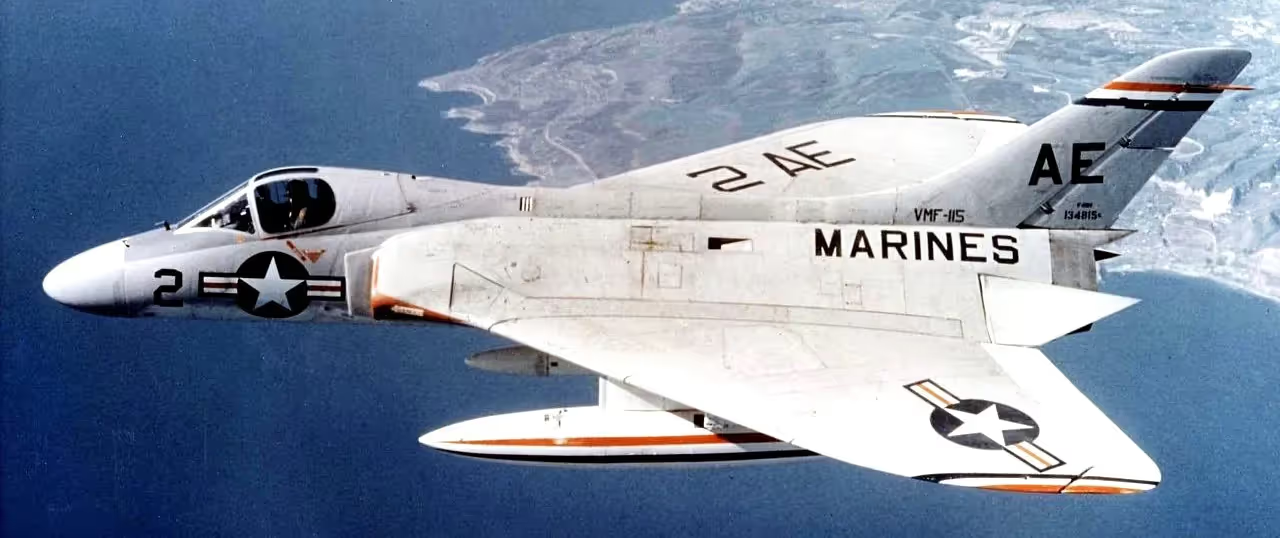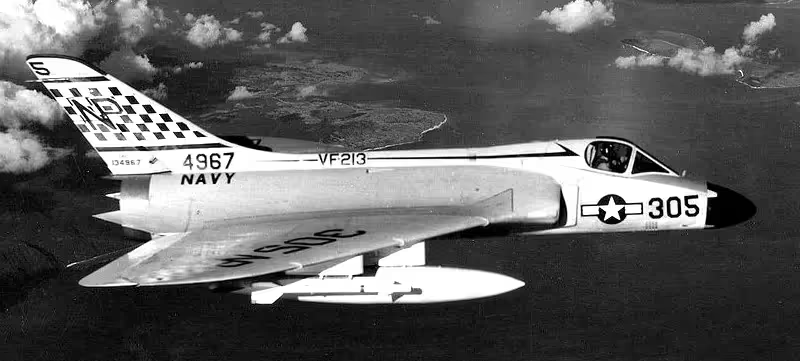Warplanes of the USA: Douglas F4D Skyray
Douglas F4D Skyray

(USMC Photo)
U.S. Marine Corps Douglas F4D-1 Skyray (BuNo 134815) of Marine Fighter Squadron 115 (VMF-115) "Able Eagles" in flight.
The Douglas F4D Skyray (later redesignated F-6 Skyray) is an American carrier-based supersonic fighter/interceptor designed and produced by the Douglas Aircraft Company. It was the first naval fighter to exceed the speed of sound in level flight and the last fighter produced by the Douglas Aircraft Company prior to its merger with McDonnell Aircraft to become McDonnell Douglas.
Development of the Skyray was started by Douglas during the late 1940s as the D-571-1 design study. It was a delta wing interceptor capable of a high rate of climb as to permit the rapid interception of approaching hostile bombers. Douglas' proposal was selected by Navy officials to fulfil a formal requirement issued in 1948. The decision to adopt the Westinghouse J40 turbojet engine to power it would lead to considerable difficulties later on as this engine would be cancelled prior to entering production. Aerodynamic issues would also lead to a protracted development cycle, considerable design changes being made even after the maiden flight of a production standard Skyray having taken place in June 1954. The Skyray was declared ready for fleet introduction in April 1956, permitting its entry to service with both the United States Navy (USN) and United States Marine Corps (USMC) shortly thereafter.
The Skyray had a relatively brief service life, during which it never participated in actual combat. Despite this, it was the first carrier-launched aircraft to hold the world's absolute speed record, having attained a top speed of 752.943 mph,[1][2] (1,211.744 km/h).[3] It also set a new time-to-altitude record, flying from a standing start to 49,221 feet (15,003 m) in two minutes and 36 seconds, all while flying at a 70° pitch angle. The last Skyrays were withdrawn from service in February 1964, although a handful continued to be flown for experimental purposes by National Advisory Committee for Aeronautics (NACA) up to the end of the decade. The F5D Skylancer was an advanced development of the F4D Skyray that ultimately did not enter service. (Wikipedia)
During April 1956, VC-3 became the first squadron to attain operational status with the F4D-1.[1] This unit was later redesignated VFAW-3 and assigned to NORAD, becoming the only United States Navy fighter squadron in what was predominantly a United States Air Force (USAF) and Royal Canadian Air Force (RCAF) organization. VFAW-3 was permanently based at NAS North Island in San Diego.The United States Marine Corps (USMC) also operated the Skyray. When the Department of Defense adopted a uniform aircraft designation system patterned on the USAF's aircraft designation system during September 1962, the F4D was redesignated as the F-6A Skyray. The F4D (old designation) should not be confused with the F-4D (new designation) – the latter being the "D" variant of the McDonnell Douglas F-4 Phantom II operated by the USAF.[18]The Skyray was designed exclusively for the high-altitude interception role, with a high rate and angle of climb. It set a new time-to-altitude record, flying from a standing start to 49,221 feet (15,003 m) in two minutes and 36 seconds, all while flying at a 70° pitch angle.[1] As a dedicated interceptor, the F4D was unsuited to the multi-mission capabilities that became increasingly in demand, thus the type had a relatively short career in both USN and USMC service. In addition to multiple Navy and Marine Corps squadrons, Naval Air Reserve and Marine Air Reserve squadrons VF-881, VF-882 and VMF-215 also flew the Skyray. The last operational squadron was VMF(AW)-115, which flew the Skyray until February 1964. A total of four aircraft were used for experimental purposes by the National Advisory Committee for Aeronautics (NACA) (which was later renamed NASA) until 1969. (Wikipedia)

(USN Photo)
U.S. Navy Douglas F4D-1 Skyrays of Fighter Squadron VF-74 "Be-Devilers" at Marine Corps Air Station Yuma, Arizona, in 1959.

(USMC Photo)
U.S. Marine Corps Douglas F4D-1 Skyray (BuNo 134804) of Marine Fighter Squadron 115 (VMF-115) "Able Eagles" in flight on 17 March 1957.

(USN Photo)
U.S. Navy Douglas F4D-1 Skyray of Fighter Squadron 141 (VF-141) "Iron Angels" landing aboard the aircraft carrier USS Bon Homme Richard (CVA-31) on 30 August 1957. VF-141 was assigned to Carrier Air Group 5 (CVG-5) aboard the "Bonnie Dick" for a deployment to the Western Pacific from 12 July to 9 December 1957.

(USN Photo)
U.S. Navy Douglas F4D-1 Skyray (BuNo 134880) from Fighter Squadron VF-141 Iron Angles and an North American FJ-3 Fury (BuNo 135857) from VF-51 Screaming Eagles on the deck of the aircraft carrier USS Bon Homme Richard (CVA-31) in 1957. Both squadrons were assigned to Carrier Air Group 5 (CVG-5) for a deployment to the Western Pacific from 12 July to 9 December 1957.

(USN Photo)
U.S. Navy Douglas F4D-1 Skyray (BuNo 134967) from Fighter Squadron VF-213 "Black Lions" in flight. VF-213 was assigned to Carrier Air Group 21 (CVG-21) aboard the aircraft carrier USS Lexington (CVA-16) for a deployment to the Western Pacific from 14 July to 19 December 1958. The Skyray is armed with AIM-9B Sidewinder missiles and flies a patrol during the 1958 Taiwan Strait Crisis.
_USS_FD_Roosevelt_1959.avif)
(USN Photo)
Three U.S. Marine Corps Douglas F4D-1 Skyray fighters of Marine all-weather fighter squadron VMF(AW)-114 Death Dealers on the catapults of the aircraft carrier USS Franklin D. Roosevelt (CVA-42), in 1959. VMF(AW)-114 was assigned to Carrier Air Group 1 (CVG-1) aboard the FDR for a deployment to the Mediterranean Sea from 13 February to 1 September 1959.

(NASA Photo)
Douglas F4D-1 (Bu. No. 134759) Skyray Plan view of airplane with Ames Pilot Don R. Heinle, Engineer L. Stewart Rolls and Crew Chief Walter Liewar. Note: Used in Flight Research at Ames; 57 Years of Development and Validation of Aeronautical Technology NASA

(USN Photo)
U.S. Navy Douglas F4D-1 Skyray (BuNo 134828) from Fighter Squadron VF-162 "Hunters" in flight. VF-162 was assigned to Carrier Air Group 6 (CVG-6) aboard the aircraft carrier USS Intrepid (CVA-11) for a deployment to the Mediterranean Sea from 3 August 1961 to 1 March 1962. Note the in-flight refueling probe on the left drop tank.

(USN Photo)
Two Douglas F4D-1 Skyray fighters (BuNo 134803, 134841) of Fighter Squadron 102 (VF-102) "Diamondbacks" in flight on 25 April 1960. VF-102 was assigned to Carrier Air Group Eight (CVG-8) aboard the aircraft carrier USS Forrestal (CVA-59) for a deployment to the Mediterranean Sea from 28 January to 31 August 1960.
-115_over_the_Med_in_1962.avif)
(USN Photo)
Four U.S. Marine Corps Douglas F4D-1 Skyray (BuNo 139065, 139084, 139196, 139207) of Marine All-Weather Fighter Squadron VMF(AW)-115 "Able Eagles" in flight. VMF(AW)-115 was assigned to Carrier Air Group 7 (CVG-7) aboard the aircraft carrier USS Independece (CVA-62) for a deployment to the Mediterranean Sea from 19 April to 27 August 1962.

(USN Photo)
Two U.S. Marine Corps Douglas F4D-1 Sykray (BuNo 139052, 139181) of Marine Fighter Squadron VMF-314 "Black Knights" in flight near Marine Corps Air Station El Toro, California

(USN Photo)
Four U.S. Navy Douglas F4D-1 Skyray from Fighter Squadron VF-13 Night Cappers in flight near Cannes, France. VF-13 was assigned to Carrier Air Group 10 (CVG-10) aboard the aircraft carrier USS Shangri-La (CVA-38) for a deployment to the Mediterranean Sea from 7 February to 28 August 1962.
_1958.avif)
(USN Photo)
U.S. Navy Douglas F4D-1 Skyray (BuNo 134891) from Fighter Squadron VF-23 "Flashers" aboard aircraft carrier USS Hancock (CVA-19) during pre-deployment carrier qualifications. VF-23 was assigned to Carrier Air Group 15 (CVG-15) aboard the Hancock for a deployment to the Western Pacific from 15 February to 2 October 1958. VF-23 was redesignated VF-151 on 23 February 1959.

(USN Photo)
A Douglas F4D-1 Skyray fighter (BuNo 134959) of fighter squadron VF-102 Diamondbacks shortly before launching from the aircraft carrier USS Forrestal (CVA-59) in 1961. VF-102 was assigned to Carrier Air Group Eight (CVG-8) for a deployment to the Mediterranean Sea from 9 February to 25 August 1961. Note the AIM-9 Sidewinder air-to-air missile on the right outboard pylon and the early-style drop-tank refueling probe on the left inboard pylon.

(USN Photo)
A U.S. Navy Douglas A3D-2 Skywarrior (BuNo 138948) of heavy attack squadron VAH-9 Hoot Owls launches from the waist catapult of the aircraft carrier USS Saratoga (CVA-60), during the NATO exercise "Operation Strikeback", in September-October 1957. A McDonnell F3H-2M (BuNo 137053) from fighter squadron VF-61 Jolly Rogers is positioned on the catapult while a Douglas F4D-1 Skyray of VF-101 Grim Reapers is waiting to be launched.
_with_F4D-1_Skyray.avif)
(USN Photo)
Pilot (NOTSnik) rocket with F4D-1 Skyray (BuNo 130747) carrier plane, Armitage Field, China Lake, 5 Aug 1958.
-115_at_MCAS_Cherry_Point_c1957.avif)
(USN Photo)
U.S. Marine Corps Douglas F4D-1 Skyray of Marine All-Weather Fighter Squadron VMF(AW)-115 "Able Eagles" undergiong maintenance at Marine Corps Air Station Cherry Point, North Carolina (USA). Note the gun ports. 1957.

(USN Photo)
U.S. Navy Douglas F4D-1 Skyray (BuNo 134927) of Fighter Squadron 102 (VF-102) "Diamondbacks" in flight over Naval Auxiliary Air Station El Centro, California (USA), on 14 April 1958, carrying a TDU-10/B Dart gunnery aerial tow target.
Survivors
Douglas XF4D-1 Skyray (BuNo. 124587), in front of the main gate of Naval Air Weapons Station China Lake, California. It is on loan from the National Naval Aviation Museum, Naval Air Station Pensacola, Florida.
.avif)
(aeroprints Photo)
.avif)
(Eric Salard Photo)
Douglas F4D-1 (F-6A) Skyray (BuNo. 134748), Pima Air and Space Museum adjacent to Davis–Monthan Air Force Base in Tucson, Arizona. It is on loan from the National Naval Aviation Museum.

(Acrotirion Photo)

(Aviationphotographer Photo)
Douglas F4D-1 Skyray (BuNo. 134764), Naval Air Station Patuxent River in St. Mary's County, Maryland. It is on loan from the National Naval Aviation Museum. 134764, was received by the Naval Air Test Center's Flight Test Division in July 1957. In July 1958, it was transferred tot he fleet, and was transferred back to the US Naval Test Pilot School in November 1961. It was retired in August 1966.

(USN Photo)
Douglas F4D-1 Skyray of Marine fighter squadron VMF(AW)-542 Tigers probably in the late 1950s at Marine Corps Air Station (MCAS) El Toro, California (USA). The F4D-1 BuNo. 134806 was accepted by the Navy on 21 July 1956 and entered operational service with Fighter Squadron VF-141 and over the course of the following six years it served in five additional Navy and Marine Corps fighter squadrons, including VF-23 and Marine All-Weather Fighter Squadrons (VMF(AW))-542, 513, 314, and 114. While with VMF(AW)-314, the aircraft deployed to Naval Air Station (NAS) Atsugi, Japan. In May 1962, the aircraft was transferred to Naval Air Test Center (NATC) Patuxent River, Maryland. Initially assigned to Research, Development, Test, and Evaluation, in 1963 it became part of the aircraft complement at the U.S. Naval Test Pilot School, where it served until 1969. On 25 November 1969, Captain George Watkins, the Chief of Staff at NATC Patuxent River, flew the aircraft on its final flight for delivery to the Naval Aviation Museum in Pensacola, Florida (USA), where it is on display ever since. This also marked the last flight by a Navy Skyray.

(RuthAS Photo)

(Ralph Goebel Photo)
Douglas F4D-1 Skyray (BuNo. 134806), National Naval Aviation Museum at Naval Air Station Pensacola, Florida.

(Carol M. Highsmith Photo)

(Mike Peel Photo)
Douglas F4D-1 Skyray (BuNo. 134836), Intrepid Sea, Air & Space Museum in New York City. Originally on display at the New England Air Museum before relocating to Intrepid in 2021.
.avif)
.avif)
(Robert Frola Photos)
Douglas F4D-1 Skyray (BuNo. 134936), Pueblo Weisbrod Aircraft Museum at Pueblo Memorial Airport, Colorado.

(LodniKranazon Photo)
Douglas F4D-1 Skyray (BuNo. 134950), Aviation Heritage Park at Naval Air Station Oceana in Virginia Beach, Virginia. It is on loan from the National Naval Aviation Museum.
.avif)
(Clemens Vasters Photo)
Douglas F4D-1 Skyray (BuNo. 139177) – Flying Leatherneck Aviation Museum at Marine Corps Air Station Miramar in San Diego, California. It is on loan from the National Naval Aviation Museum.Douglas F4D Skyray





